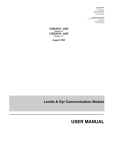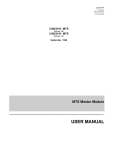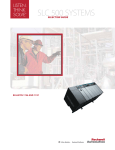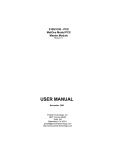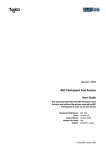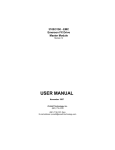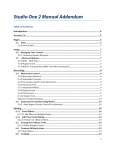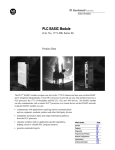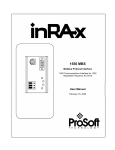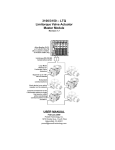Download USER MANUAL - ProSoft Technology
Transcript
Corporate Office 1675 Chester Ave. Fourth Floor Bakersfield, CA 93301 (661) 716-5100 Phone (661) 716-5101 Fax 3100/3101-SYS Revision 1.5 3150/3151-SYS Revision 1.5 February 1996 Systronics Communication Module ______________________________________________________ USER MANUAL TABLE OF CONTENTS I. Card Overview ...................................................................................................... 1 II. Systronics VSAT Programming Considerations .................................................... 3 2.1 Systronics VSAT Communications............................................................ 3 2.1.1 Command/Reply Cycle ............................................................... 3 2.1.2 Report by Exception ................................................................... 3 2.1.3 Command Types in the Systronics Slave ................................... 4 2.1.4 Command Error Checking .......................................................... 4 2.1.5 Data Integrity .............................................................................. 4 2.2 Module Memory Layout............................................................................. 4 2.2.1 Data Memory .............................................................................. 4 2.2.2 Communications Configuration Parameters ............................... 5 2.2.3 File 30h and 3Ch Configuration Values ...................................... 5 III. SYS Module Theoretical Operation....................................................................... 7 3.1 Moving Data to the Module ....................................................................... 7 3.1.1 Communications Configuration Parameters ............................... 8 3.1.2 Moving Register Data (Block ID Codes 0-4) ............................... 11 3.1.3 File 30h and 3Ch Setup Data (Block ID Codes 5&6) .................. 13 3.2 Receiving Write Data from a Host............................................................. 14 3.2.1 Setpoint Select Command (File # 21h) ....................................... 14 3.2.2 Momentary Control Command (File # 1Dh) ................................ 15 3.2.3 Accumulator Reset Command (File # 44h) ................................. 15 3.2.4 Multi-Streaming File Data Setup (File #30h) ............................... 16 3.2.5 VSAT Timer File Setup ( File #3Ch) ........................................... 16 3.2.6 Write Real Time Clock ( File #05h) ............................................. 16 3.2.7 Pulse Train Control Select File ( File #2Ch)................................ 16 3.3 Module Status ........................................................................................... 17 3.3.1 Slave Error Code Table .............................................................. 17 3.3.2 Error Status Codes ..................................................................... 19 IV Configuring the Module......................................................................................... 21 4.1 Hardware Overview................................................................................... 21 4.2 Module Jumper Configurations ................................................................. 21 4.2.1 3100/3101 for the 1771 Platform................................................ 21 4.2.2 3150/3151 for the 1746 Platform................................................ 22 4.3 Firmware Installation Procedure ( 3101 & 3151 ) ...................................... 23 4.3.1 1771-DB Revision B Module....................................................... 23 4.3.2 1746-BAS Module ...................................................................... 23 V. Systronics Slave Commands ................................................................................ 25 5.1 Systronics Command Structure................................................................. 25 5.1.1 File # 14h - Read Analog Data ................................................... 25 5.1.2 File # 19h - Read Status Data .................................................... 25 5.1.3 File # 47h - Read Current End of Batch Data - 32 bit ................. 25 5.1.4 File # 37h - Read Accumulator Data - 32 bit............................... 25 5.1.5 File # 1Dh - Momentary Control Select ....................................... 25 5.1.6 File # 21h - Setpoint Select ........................................................ 26 5.1.7 File # 23h - Execute Selected Control File.................................. 26 5.1.8 File # 30h - Multi-file Streaming Data Setup ............................... 26 5.1.9 File # 3Fh - Multi-file Streaming Data ......................................... 26 5.1.10 File # 3Ch - VSAT Timer Setup ................................................ 26 5.1.11 File # 3Eh - 20 msec Timer....................................................... 26 5.1.12 File # 41h - Analog Deviation Limits ......................................... 26 5.1.13 File # 44h - Accumulator Reset Commands ............................. 27 5.1.14 File # 4Bh - Tank Levels ........................................................... 27 5.1.15 File # 2Ch - Pulse Train Control Select File .............................. 27 VI Hardware Diagnostics ........................................................................................... 29 6.1 3100/3101 PLC Platform........................................................................... 29 6.2 3150/3151 SLC Platform........................................................................... 30 VII Support, Service and Warranty............................................................................. 33 7.1 Technical Support ..................................................................................... 33 7.2 Service and Repair.................................................................................... 33 7.3 Warranty ................................................................................................... 34 7.3.1 General Warranty Policy............................................................. 34 7.3.2 Limitation of Liability ................................................................... 34 7.3.3 Hardware Product Warranty Details ........................................... 34 APPENDICES Appendix A PLC-5 Example Ladder Logic SLC Example Ladder Logic Appendix B Definitions of RS-232C Handshaking Signals RS-232C Cable Configuration RS-422/RS-485 Cable Configuration Appendix C 3100/3101 Jumper diagrams 3150/3151 Jumper diagrams Appendix D Product Revision History Appendix E Systronics Protocol Specification (Provided by Conoco) I. Card Overview The ProSoft Technology, Inc. Systronics VSAT Slave firmware upgrade gives Allen-Bradley 1771 and 1746 I/O compatible processors the ability to interface to a Systronics VSAT Master device on up to two ports per module. The product includes the following capabilities: Revised 06/26/98 • Foxboro / Systronics Minimote RTU Protocol • Two fully configurable serial ports, each capable of supporting the full implementation of the protocol • Binary Data Stream with CRC-16 Error Checking • Supported File Numbers: 14h Analog Data 19h Status Data 37h Accumulator Data - 32 bit 1Dh Momentary Control Select 21h Setpoint Select 23h Execute Selected Control File 2Ch Pulse Train Control File 30h Multi-file Streaming Data Setup 3Fh Multi-file Streaming Data 3Ch VSAT Timer Setup 3Eh 20 msec Timer 41h Analog Deviation Limits 44h Accumulator Reset Commands 47h 32 bit Accumulator Current End of Batch 4Bh Tank Levels • Master Broadcast Addressing to Slaves (#127) • Software configuration (From PLC) Address : 1 to 126 Parity : None, odd, or even, Stop Bit : 1 or 2 Baud Rate : 300 TO 38,400 • Hardware RS-232C handshaking for modem and radio applications • RS-422/RS-485 compatible for multi-drop applications 1 (This page intentionally left blank) 2 Revised 06/26/98 II. Systronics VSAT Programming Considerations 2.1 Systronics VSAT Communications The ProSoft Systronics VSAT Slave module runs the Systronics Minimote protocol. This capability allows the module to communicate data from a PLC/SLC to a Systronics Master and vice-versa. The module supports both point-to-point as well as multi-drop implementations. The following discusses the functional capabilities of the Prosoft card. 2.1.1 Command/Reply Cycle Successful communications between a Systronics Slave and a Master will always consist of the following two transactions: Command: Message from master giving instruction to slave. Reply: Response to command. A slave station will respond to a master issued command in several ways. Data Message: If the command was executed by the slave, the response message will include the data requested, or an acknowledgement that the command was executed. Error Message: If the command could not be executed by the slave, for whatever reason, an error response message is transmitted to the master. No Reply: If the master does not detect a reply within its timeout period, the master should re-transmit the command, before a time out error is issued. If the Slave could not decode the message or an error occurred preventing the Slave from recognizing the message, no response will be issued. 2.1.2 Report by Exception The Systronics Slave may also report by exception. Any change noted in the Status bits (19h) or Analog values exceeding deviation limits (14h) will generate a message from the slave to the master. This message will transmit the current Status or current Analog data to the master. Timing for the transmission of these messages is configured using file 3Ch. File 3Fh is multiple file report command which will return all data on a periodic basis, as determined by the user configuration in file 3Ch. Revised 06/26/98 3 2.1.3 Command Types in the Systronics Slave The Systronics Slave can respond to two types of commands from the master; read data and write data. These are discussed collectively in Section V since some command types are both read and write types. 2.1.4 Command Error Checking When the Systronics Slave cannot execute a command, an error code is generated and returned to the master. Error codes generated at the slave will usually be indicative of an illegal function, an illegal address, bad data, or the inability to complete a transaction because of a network problem. 2.1.5 Data Integrity As in all good protocols, there must exist a level of data integrity checking to verify, with some degree of assurance, the quality of the transmitted data. The Systronics protocol supports two types of error checking: • • 16 bit cyclic redundancy check (CRC-16) One bit parity check A key criteria to keep in mind when implementing a network is to make sure that the master and all the slaves are configured with the same error checking method. CRC-16: When the master generates a message, a 16 bit CRC value is added to the end of the transmitted packet. The CRC value is generated using a series of bit shifts and manipulations. The receiving station executes the same calculation on the data and verifies the transmitted CRC. Any discrepancy will cause the message to be disregarded. Parity: Parity checking can be added as an additional level of data security. If parity checking is selected, even or odd parity can be implemented. 2.2 Module Memory Layout This section explains the different segments of the memory which are utilized in the PLC and in the Systronics Slave module. 2.2.1 4 Data Memory Data is transferred from the PLC/SLC to the module asynchronously from the Master's data read requests. This allows the application ladder logic to manipulate and position the data as needed before transfer to the module. Since the module stores the data from the ladder logic in local memory, read requests from the Master are serviced immediately. Revised 06/26/98 The data registers are moved over the backplane between the module and the processor using the standard Block Transfer read and write functions, in the case of a PLC, and M0/M1 file transfers in the case of an SLC. The module controls the data which is transferred from the module to the PLC/SLC during a read (BTR or M1 instruction) from the module. Being a slave module, the only time valid 'data' is transferred to the ladder logic is when a write command is issued from the Master. When writing data from the ladder logic to the module (BTW or M0 instruction), the ladder logic controls the data written to the module. Appendix A contains a PLC5 and a SLC program showing an example of the logic to transfer data registers to and from the module. Section III discusses the transfer mechanism in detail, as well as several important relationships between PLC / SLC addressing, module addressing, and protocol addressing. The relationship between the Systronics addressing and the processor’s addressing is shown in the figure below. The processor programs in Appendix A are designed to support this data table configuration. In order to modify the flow and / or directions of the data, the example ladder logic needs to be modified. Filetype 16 bit registers 16 bit binary 32 bit acc EOBatch 32 bit accumulator Tank Levels Momentary Control File #’s 14h 19h 47h 37h 4Bh 1Dh Setpoint Select 21h Accumulator Reset 44h Valid Addresses 0 - 61 0 - 123 0 - 15 0 - 31 0 - 31 Bit:0 - 255 Card 0 - 15 Reg:0 - 4095 1 -2 PLC / SLC Addresses N12:0 - N12:49 N12:50 - N12:99 N12:100 - N12:149 N12:150 - N12:199 N12:200 - N12:249 B13:0 - B13:15 N11:0 - N11:32 B13:16 - B13:17 Relationship between Systronics addressing & PLC / SLC Data Tables Revised 06/26/98 2.2.2 Communications Configuration Parameters The communications configuration parameter data block contains the information necessary for the module to set up the module's communications ports. On power up, the module will not proceed without receiving this configuration block. 2.2.3 File 30h and 3Ch Configuration Values The configuration values for File 30h (Multi-File Streaming Data Setup) and File 3Ch (VSAT Timer Setup) are stored in the processor data image. This image may be edited manually as well as being updated by downloads from a host. 5 (This page intentionally left blank) 6 Revised 06/26/98 III. SYS Module Theoretical Operation Data transfers between the processor and the ProSoft Technology module occur using the Block Transfer commands, in the case of the PLC, and M0/M1 data transfer commands, in the case of the SLC. These commands transfer up to 64 physical registers per transfer. The logical data length changes depending on the data transfer function. The following discussion details the data structures used to transfer the different types of data between the ProSoft Technology module and the processor. The term 'Block Transfer' is used generically in the following discussion to depict the transfer of data blocks between the processor and the ProSoft Technology module. Although a true Block Transfer function does not exist in the SLC, we have implemented a pseudo-block transfer command in order to assure data integrity at the block level. Examples of the PLC and SLC ladder logic are included in Appendix A. In order for the ProSoft Technology module to function, the PLC must be in the RUN mode, or in the REM RUN mode. If in any other mode (Fault/PGM), the block transfers between the PLC and the module will stop, and communications will halt until block transfers resume. [ Note: PLC Version ONLY ] 3.1 Moving Data to the Module This section discusses how to transfer Data, Status and Analog data to the ProSoft module. Data transfer to the module from the processor is executed through the Block Transfer Write function. The different types of data which are transferred require slightly different data block structures, but the basic data structure is: WORD 0 1-63 DESCRIPTION Block ID code Data In a PLC, the BTW length must be configured for 64 words. In an SLC, the M0 file should be configured for 64 words. Otherwise module operation will be unpredictable. where: BLOCK ID CODE: A block identifier code between 0-6 and 255 in value. This code is used by the ProSoft module to determine what to do with the data block. Valid codes are: Revised 06/26/98 7 CODE 0-6 255 DESCRIPTION File and Data Identifier Communication Configuration Parameters DATA: The data to be written to the module. The structure of the data is dependent on the block ID code. Sections 3.1.1 and 3.1.2 provide details on the different structures. 3.1.1 Communications Configuration Parameters The ProSoft Technology firmware communication parameters must be configured at least once when the card is first powered up, and any time thereafter when the parameters must be changed. On power up, the module enters into a logical loop waiting to receive configuration data from the processor. While waiting, the module sets the first word of the BTR buffer to 255, telling the processor that the module must be configured before anything else will be done. The module will continuously perform block transfers until the communications configuration parameters block is received. Upon receipt, the module will begin execution. Transferring the Communications Configuration Parameters to the module will force a reset of the communication port, as well as dropping DTR to reset any attached hardware. The configuration data block structure which must be transferred from the processor to the module is as follows: Data Word Description Block ID Header = 255 Port 1 0 1 2 3 4 5 6 7 8 9 N[]:0 N[]:1 N[]:2 N[]:3 N[]:4 N[]:5 N[]:6 N[]:7 N[]:8 N[]:9 Port Configuration Word Address (if configured as a Slave) Baud Rate RTS to TxD Delay RTS off Delay Message Response Timeout Inter-character timing Momentary Select Count Setpoint Select Count Setpoint Table Initialize 10 11 12 13 N[]:10 N[]:11 N[]:12 N[]:13 Port Configuration Word Address (if configured as a Slave) Baud Rate RTS to TxD Delay Port 2 8 Revised 06/26/98 14 15 16 17 18 19 N[]:14 N[]:15 N[]:16 N[]:17 N[]:18 N[]:19 RTS off Delay Message Response Timeout Inter-character timing Momentary Select Count Setpoint Select Count Setpoint Table Initialize System Configuration 20 N[]:20 Not Used 21 N[]:21 Not Used 22 N[]:22 Not Used 23 N[]:23 Not Used 24 N[]:24 Not Used 25 N[]:25 Block Transfer Delay Counter Where: For Port 1 and Port 2 Port Configuration Word: This register contains several communication configuration parameters encoded into the word. These are as follows: Type: The operating mode of the port is selected by these bits: Bits 3210 0001 Systronics Slave (Other modes not valid at this time) Stop Bits: The number of stop bits to be used is defined as follows: Bits 13 12 0 0 0 1 1 x One stop bit Two stop bits Invalid Port Configuration Parity: The parity mode to be used by the module is defined by this word as follows: Bits 15 14 0 0 0 1 1 0 1 1 No parity Odd parity Even parity Invalid Port Configuration Baud Rate: The baud rate at which the module is to operate. The baud rate is configured as follows: Revised 06/26/98 9 Value 0 1 2 3 4 5 6 7 Baud Rate 300 Baud 600 Baud 1200 Baud 2400 Baud 4800 Baud 9600 Baud 19200 Baud 38400 Baud The module’s two ports are limited to an upper baud rate of either 19200 or 38400 baud. The module cannot be configured with one port at 19200 and the other at 38400. If an attempt is made to configure the module in this fashion, a Port Configuration Error will be returned. RTS To TXD Delay: This value represents the time in 1 ms increments to be inserted between asserting RTS, and the actual transmission of data. The delay, if greater in duration than the hardware time delay associated with CTS, will override the CTS line until the time-out is complete. This configurable parameter is useful when interfacing with modem based devices, or anytime line noise must be allowed to subside before data is transmitted. RTS Off Delay: The value in this word represents the number of 1 ms time delay increments inserted after the last character is transmitted and before RTS is dropped. The module automatically inserts a one character width Off Delay, assuring that RTS does not drop until after the last character has been completely sent. Unless working under unusual conditions, this value will normally be configured with a value of 0. The maximum value to be used is 65535 (0xffff). Message Response Timout: This register represents the message response timeout period in 1 ms increments. This is the time which a port configured as a Master will wait before retransmitting a command if no response is received from the addressed slave. The value is set depending on the expected slave response times. The allowable range of values is 0 to 65535(0xffff). If a zero value is entered, the module will default to a one second timeout value (1000 ms). Inter-character Timing: This register is used in situations where the end of message character timeout delay must be extended beyond the normal 3.5 character widths. The value entered 10 Revised 06/26/98 represents the number of 1 ms intervals of ‘no transmission’ which will be counted prior to accepting a message. This parameter will be useful in satallite or packet radio installation where a data transmission may be split between two packets. Increasing this value beyond the system’s packet handling time will eliminate timeout errors. Momentary Select Count: Valid values are from 0 - 32. This parameter informs the Systronics host how many 8 point cards of I/O this station contains. Setpoint Select Count: Valid values range from 0 -32. This parameter informs the Systronics host of how many setpoints this station will accept. Setpoint Table Initialization: If equal to 1 (or LSB = 1), initializes setpoint write table to 0’s. System Configuration Block Transfer Delay Counter: This value is used by the module to slow down the block transfer loading between the module and the processor. Excessive Block Transfers can slow down the response time of the SYS’s communication ports. This parameter has been provided to allow the Block Transfer timing to be determined on an application basis. A value of 0 is normally used at the factory and is recommended as a starting point. 3.1.2 Moving Register Data (Block ID Codes 0-4) The movement of data to the module is executed through a block transfer write with the following structure: Word 0 Word 1 Word 2-63 : : : Block ID Entity Count Data where: Block ID: The Block ID is used by the module to decode which file the data is intended for. The relationship between block ID number and file type is as follows: Block ID 0 1 2 3 4 Revised 06/26/98 File Type 14h - Analog Data 19h - Status Data 47h - 32 bit Accum Current End of Batch 37h - 32 bit Accumulator 4Bh - Tank Level - BCD 11 Entity Count: This value represents the size of the file data block that is available to the master. The master uses this value to determine how many registers values to request. Valid values are as follows: Block ID 0 1 2 3 4 Entity Count 0 to 62 0 to 124 0 to 31 0 to 31 0 to 31 Data: This field contains the data that is to be transmitted to the master if a request is received. The data structures are as follows: Block ID 0: Word 2: Word 3: Word 63: Analog Data 16 bit integer data 16 bit integer data 16 bit integer data Block ID 1: Status Data The status data is arranged as follows within a word, starting at word 2: Word X : 12 High byte Low byte : Entry #1 : Entry #2 Hold for verification Block ID 2: Word 2: Word 3: Word 3: Word 4: Word 5: Word 6: Word 34: Word 35: 32 bit Accumulator Current End of Batch Rollover Flags (1-16) Shift Flags (1-16) Accum # 1 ( Value / 10000) Accum # 1 ( Value MOD 10000) Accum # 2 ( Value / 10000) Accum # 2 ( Value MOD 10000) Accum # 16( Value / 10000) Accum # 16( Value MOD 10000) Block ID 3: Word 2: Word 3: Word 4: Word 5: Word 62: Word 63: 32 Bit Accumulator Accum # 1 ( Value / 10000) Accum # 1 ( Value MOD 10000) Accum # 2 ( Value / 10000) Accum # 2 ( Value MOD 10000) Accum # 31( Value / 10000) Accum # 31( Value MOD 10000) Block ID 4: Word 2: Word 3: Word 4: Word 5: Word 31: Word 32: Tank Level Level #1 - 16ths of inches Level #2 - 16ths of inches Level #3 - 16ths of inches Level #4 - 16ths of inches Level #31 - 16ths of inches Level #32 - 16ths of inches Revised 06/26/98 3.1.3 File 30h and 3Ch Setup Data (Block ID Codes 5&6) The movement of data to the module is executed through a block transfer write with the following structure: Word 0 Word 1-51 : : Block ID 5 & 6 Data Block where: Block ID: The Block ID is used by the module to decode which file the data is intended for. The relationship between block ID number and file type is as follows: Block ID 5 6 File Type 30h - Multi-File Streaming Data Setup 3Ch- VSAT Timer Setup Data: This field contains the data that is to be transmitted to the master if a request is received. The data structures are as follows: Revised 06/26/98 Block ID 5: Word 1 Word 2 Word 3 Word 22 Word 23 Word 24 Word 25 Word 26 Word 27 Word 46 Word 47 Word 48 Setup Data for Port 1 and 2 File Number to read - Entry 0, Port 1 Starting Entry to read - Entry 0, Port 1 Number of Entries - Entry 0, Port 1 File Number to read - Entry 7, Port 1 Starting Entry to read - Entry 7, Port 1 Number of Entries - Entry 7, Port 1 File Number to read - Entry 0, Port 2 Starting Entry to read - Entry 0, Port 2 Number of Entries - Entry 0, Port 2 File Number to read - Entry 7, Port 2 Starting Entry to read - Entry 7, Port 2 Number of Entries - Entry 7, Port 2 Block ID 6: Word 1 Word 2 Word 15 Word 16 Word 17 Word 18 Word 31 Word 32 VSAT Timer Setup - Port 1 and 2 File Number to send - Entry 0, Port 1 Preset Timer Value - Entry 0, Port 1 File Number to send - Entry 7, Port 1 Preset Timer Value - Entry 7, Port 1 File Number to send - Entry 0, Port 2 Preset Timer Value - Entry 0, Port 2 File Number to send - Entry 7, Port 2 Preset Timer Value - Entry 7, Port 2 13 3.2 Receiving Write Data from a Host This section discusses how to get data written to the ProSoft module by a Master into the processor. The transfer of data from the ProSoft Technology module to the processor is executed through the Block Transfer Read function. Three different types of data are moved from the module into the processor. The data structure for the block transfer depends on the type of block data. Note that the module supports the direct control and select modes of writes. In a PLC, the BTR length must be configured for 64 words. In a SLC, the M1 file must be configured for 64 words. Otherwise module operation will be unpredictable. 3.2.1 Setpoint Select Command (File # 21h) In order to allow the transfer of variable length data fields into any part of the Processor’s data table (i.e.: to support variable length register writes) the Read data block from the module is structured as follows: WORD 0 1 2 - 33 DESCRIPTION Setpoint Write (bit 0) = 1 Register address Setpoint Data Values where: Register Write: This word (bit) is used to tell the Processor that a new register write command has been issued by a Master and to transfer the data that follows into the Processor’s data table. When the write command is received by the slave module, bit 0 of the word 0 is set. Once the transfer is complete, the Systronics module resets the bit. Bit 0 can then be used by the Processor logic to condition the transfer of data from the BTR buffer into the Processor’s data table. Note that the Processor application program need not reset the bit. Register Address: This register represents the offset address into which the write data block will start to be written. This register can be used to point directly into the Processor’s data table, as in the Appendix A example. The register address is calculated as follows: Address: (I/O card x 2) + (point - 1) 14 Revised 06/26/98 Data: A table of up to 32 values containing the results of the write commands from the Systronics master. Write commands from a host are received into this table at the addressed position. The entire table is moved with each write. This table may be initialized to 0 by setting the Setpoint Table Initialization Bit and issuing a module configuration. 3.2.2 Momentary Control Command (File # 1Dh) In order to set a bit within the Processor’s data table, the Read Data Block has been structured as follows: WORD 0 1 - 16 DESCRIPTION Bit Set (bit 1) = 2 Binary image (16 words) where: BIT SET: Word 0, bit 1 of the data block is used to tell the Processor that a new bit set/reset command has been received from the master. When the “Bit Set/Reset” bit is set, (bit 1 = 1), the ladder logic is enabled to act on the Processor’s data table. The exact action that the Processor will take is dependent on the next two words. Note that the Systronics slave module will reset this bit after the transfer, and therefore the application need not reset the bit. BINARY IMAGE: The bit wrtie command is received by the module and is used to set the appropriate bit in the 16 word image. The active 16 words are moved to the ladder logic. Once the block has been moved, the bit is immediately reset in the module’s image so that on the next write command the last written bit will no longer be set. 3.2.3 Accumulator Reset Command (File # 44h) In order to reset the 16 and 32 bit Accumulators, the Read Data Block is structrured as follows: WORD 0 1-2 DESCRIPTION Bit Set (bit 2) = 4 Reset Accumulator Bit Image where: BIT SET: Word 0, bit 2 of the data block is used to tell the Processor that an Accumulator Reset command has been received from the Systronics master. RESET ACCUMULATOR BIT IMAGE: When an Accumulator Reset command is received by the module, a bit in the ‘Reset Bit Accumulator Image’ is set, corresponding to the addressed Revised 06/26/98 15 accumulator. The ladder logic should use the bit, with a ‘ONS’ (One Shot) to trigger the reset logic. Once the block has been moved, the bit is immediately reset in the module’s image so that on the next write command the last written bit will no longer be set. 3.2.4 3.2.5 3.2.6 3.2.7 16 Multi-Streaming File Data Setup (File #30h) When a File 30h write is received from the host, whether a partial file write or a complete file write, the File 30h image that is maintained in the module is moved down to the processor. The ladder logic can selectively store this data to assure that under power up conditions, the slave still maintains reporting capabilities. (Note that the data for both ports is moved to the processor no matter which port the write comes in on). WORD 0 DESCRIPTION File 30h write = 5 1-48 Per structure detailed in Section 3.1.3 VSAT Timer File Setup ( File #3Ch) When a File 3Ch write is received from the host, whether a partial file write or a complete file write, the File 3Ch image that is maintained in the module is moved down to the processor. The ladder logic can selectively store this data to assure that under power up conditions, the slave still maintains reporting capabilities. (Note that the data for both ports is moved to the processor no matter which port the write comes in on). WORD 0 DESCRIPTION File 3Ch write = 6 1-32 Per structure detailed in Section 3.1.3 Write Real Time Clock ( File #05h) When a File 05h write is received from the host, whether a partial file write or a complete file write, the File 05h image that is maintained in the module is moved down to the processor. The ladder logic can selectively store this data to assure that under power up conditions, the slave still maintains reporting capabilities. (Note that the data for both ports is moved to the processor no matter which port the write comes in on). WORD 0 DESCRIPTION File 05h write = 7 1-32 Per structure detailed in Section 3.1.3 Pulse Train Control Select File ( File #2Ch) When a File 2Ch write is received from the host, the data received from the host is moved to the ladder logic. (Note that the Revised 06/26/98 data for both ports is moved to the processor no matter which port the write comes in on). WORD 0 1 2 3 DESCRIPTION File 2Ch write = 8 Point Address Pulse Train Count Pulse train period Note that the SYS module is limited to receiving one Pulse command per transmission. Point Address: This register represents the point address which is being commanded to pulse by the host. This register can be used to point directly into the Processor’s data table. The register address is calculated as follows: Address: (I/O card x 2) + (point - 1) Pulse Train Count: Number of pulse cycles as commanded by the host Pulse Train Period: The pulse period, in milliseconds, as commanded by the host 3.3 Module Status This section discusses how to get module status data from the module into the processor. 3.3.1 Slave Error Code Table The SYS Module monitors the status of all Slave port commands. This status is communicated to the processor in the form of a Slave Error Code Table. The Slave Error Code Table is initialized to zero on power up, and every time the module receives the 255 configuration data block. The Slave Error Table is a 20 word block. The Table is returned to the ladder logic anytime the BTR Block ID is equal to 0. The structure of the data block is as follows: WORD Port 1 0 1 2 3 4 Revised 06/26/98 DESCRIPTION Current port status Last transmitted error condition Total Messages to this slave Total Msg responses from this slave Total Msgs seen by this slave 17 Port 2 5 Current port status 6 Last transmitted error condition 7 Total Messages to this slave 8 Total Msg responses from this slave 9 Total Msgs seen by this slave System Information 10-11 Product Name (ASCII) 12-13 Revision (ASCII) 14 (blank) 15 Production Run Number 16-19 Spare Where: Current Port Error Status: This value represents the current value of the error code for the port. This value will only be valid if the port is configured as a Slave. The possible values are detailed in the following section. Last Transmitted Error Code: This value is the last error code transmitted to the master by this slave port. Error codes which can be expected in this field are 0, 1, 2, 3, and 6. The field will only be cleared by re configuring the module (Block ID 255). Total Messages to This Slave: This value represents the total number of messages that have matched this slaves address on this port, whether the slave actually determined them to be good (worthy of response) or not. Total Message Responses From This Slave: This value represents the number of good (non-error) responses that the slave has sent to the master on this port. The presumption is that if the slave is responding, the message was good. Total Messages Seen By This Slave: This value represents the total number of commands seen by the slave on this port, regardless of the slave address. All counters in the Slave Error Table will rollover to 0 after reaching 65535 Product Name: These two words represent the product name of the module in an ASCII representation. In the case of the SYS product, the letters ‘ SYS ‘ should be displayed when placing the programming software in the ASCII data representation mode. 18 Revised 06/26/98 Revision : These two words represent the product revision level of the firmware in an ASCII representation. An example of the data displayed would be ‘1.20’ when placing the programming software in the ASCII data representation mode. Blank: Not used at this time Production Run Number: This number represents the ‘batch’ number that your particular chip belongs to. This number should appear as a number equal or greater than 1. This should help the factory determine when the User’s chip was created. 3.3.2 Error Status Codes The Error Codes returned in the Slave Error Code Table reflect the outcome of the commands and responses executed by the module. Note that in all cases, if a zero is returned, there was not an error. Valid Error Status Codes are as follows: Code 0 Revised 06/26/98 Description All OK The module is operating as desired. 1 Illegal Function An illegal function code request has been received from the master 253 Port 1 DCD not Active Port 1 of the module has been designated the VSAT port and requires the DCD signal to operate correctly 254 Checksum Error The slave determined that the message checksum was in error, and therefore discarded the message 255 TX Hardware Time-out A time-out has occurred in the transmission of the command from the master, and the command has been aborted. This error is usually an indication that the CTS signal is not being received by the module. 19 (This page intentionally left blank) 20 Revised 06/26/98 IV Configuring the Module 4.1 Hardware Overview When purchasing the MCM product, there are two available choices for each platform. These choices are as follows: ProSoft Cat Num PLC SLC 3100-SYS 3150-SYS 3101-SYS 3151-SYS Description Module provided by ProSoft Firmware only When purchasing the module from ProSoft Technology, many of the jumper configurations will have been factory set. When purchasing the firmware from ProSoft Technology and the Allen-Bradley module from another source, particular attention must be paid to hardware configuration. 4.2 Module Jumper Configurations The following section details the available jumper configurations for the 1771 and 1746 platform solutions. As needed, differences between the module based solutions and the firmware based solutions are highlighted. 4.2.1 Revised 06/26/98 3100/3101 for the 1771 Platform Following are the jumper positions for the 1771-DB Rev B module and the ProSoft Technology 3100-SYS module (See Appendix D for details on jumper locations): Jumper 3100-SYS 3101-SYS JW1 JW2 JW3 JW4 JW5 JW6 JW7 JW8 JW9 N/A N/A N/A Not Used 16 Pt Not Used Enabled As Needed As Needed Enabled 32K PROM Turbo ASCII/ASCII 16 Pt Not Used Enabled As Needed As Needed JW1 Watchdog Enable / Disable Enable The position of this jumper does not affect the operation of the unit under normal operations. In order to enable the watchdog function, simply place the jumper in the Enabled position. JW2 PROM select 32K PROM The position of this jumper is very important to the successful operation of the module. In order to operate with our MCM EPROM, the jumper must be in the 32K PROM position. JW3 Speed select (Normal / Turbo) Turbo 21 The position of this jumper does not affect the operation of the unit under normal operations. Unless there are reasons not to operate in the Turbo mode, we recommend operating in the Turbo mode. JW4 A B C D Port 1 and 2 configuration Position A The position of this jumper set must be changed from the shipped default position (D) to the A position. Operation of the module will be unpredictable if the jumper set is not in the A position. PRT 1 = ASCII PRT 1 = PGM PRT 1 = PGM PRT 1 = PGM DEFAULT PRT 2 = ASCII PRT 2 = ASCII PRT 2 = DF1 PRT 2 = ASCII DH485 = PGM DH485 = RUN DH485 = DISABLED DH485 = RUN JW5 Backplane 8/16 point 16 Point The module has only been tested in the 8 and 16 point modes and has successfully operated in both positions. The 8 point mode should be used when installing the module into old PLC-2 installations. JW6 Port 2 Baud Rate Not Used This jumper is not used by the MCM firmware. All baud rate configuration is performed through the ladder logic data table. JW7 Battery Enable / Disable Enabled This jumper should be placed in the Enabled position when the module is powered up. Although not critical to the operation of the module, this will back up some data registers in the module during a power failure or reset. JW8/9 RS Configuration for Port 1 and 2 See options on module The default from factory is RS-232, but all options are supported by the MCM firmware 4.2.2 3150/3151 for the 1746 Platform Following are the jumper positions for the 1746-BAS module and the ProSoft Technology 3150-SYS module (See Appendix D for details on jumper locations): JW1/2 Jumper 3150-SYS 3151-SYS JW1 JW2 JW3 JW4 As Needed As Needed N/A N/A As Needed As Needed 3-5, 4-6 1-3, 2-4 RS configuration for port 1 and 2 See Appendix D The default from factory is RS-232, but all options are supported by the MCM firmware JW3 Memory Selection 3-5, 4-6 When using the 3151 firmware solution with a 1746-BAS module, the EPROM is plugged into the User Socket. When in this configuration, it is essential that the jumper be in the correct position. With the 3150 module, this jumper will not affect operation of the product. 22 Revised 06/26/98 JW4 Mode Configuration 1-3, 2-4 When using the 3151 firmware solution with a 1746-BAS module, it is essential that the jumper be in the correct position. With the 3150 module, this jumper will not affect operation of the product. 4.3 Firmware Installation Procedure ( 3101 & 3151 ) The following section details the available jumper configurations for the 1771 and 1746 platform solutions. As needed, differences between the module based solutions and the firmware based solutions are highlighted. 4.3.1 4.3.2 1771-DB Revision B Module The firmware installation steps are as follows: 1. Remove the card cover from the module 2. Plug the ProSoft Technology EPROM into the module's User Socket. Align the notches on the EPROM plastic carrier with the notches in the User socket. Make sure the EPROM is well seated 3. Replace the card cover 4. Turn the module over and locate the identification sticker in the unused indent. This sticker will be important should the module ever require service. 1746-BAS Module The firmware installation steps are as follows: 1. Plug the ProSoft Technology EPROM into the module's User Socket. Align the notches on the EPROM plastic carrier with the notches in the User socket. Make sure the EPROM is well seated 2. Remove the plastic lens cover from the 1746BAS module and slip on the new cover provided with the firmware. Make sure the cover is firmly affixed to the module Once the firmware has been installed and the module’s jumpers have been verified, the hardware is ready to be inserted into the I/O rack. Revised 06/26/98 23 (This page intentionally left blank) 24 Revised 06/26/98 V. Systronics Slave Commands The ProSoft Technology Systronics Slave module supports several data read and write commands. The decision on which command to use is made depending on the type of data being addressed, and the level of Systronics support in the slave and master equipment. The following sections detail the different commands supported by the module. 5.1 Revised 06/26/98 Systronics Command Structure The Systronics Slave module supports the following commands. As stated in earlier sections, the data for responding to read commands is taken directly out of module memory, while write data from the Master is sent directly to the processor ladder logic, bypassing the module memory table. 5.1.1 File # 14h - Read Analog Data The Systronics Slave module supports the transfer of up to 62 words in this file. In the normal protocol, this data would be limited to 12 bit signal analog values. The module will transfer 16 bit values unaltered from the PLC to the host. 5.1.2 File # 19h - Read Status Data The Systronics Slave module supports the transfer of up to 62 words (124 bytes) of status data. The data values may be transferred in from a binary file or from an integer file. 5.1.3 File # 47h - Read Current End of Batch Data - 32 bit The Systronics Slave module transfers up to 16 32-bit accumulator values. The accumulator data is organized such that the ladder logic can operate with two stacked counters. The low word counter is a 0 to 9999 counter, while the high counter increments each 10000th count. The data is organized in the form of 2 integers, where the first integer is the high word (Value / 10000) and the second integer is the low word (Value MOD 10000). 5.1.4 File # 37h - Read Accumulator Data - 32 bit The module transfers 31 32-bit numbers to the master. The accumulator data is organized such that the ladder logic can operate with two stacked counters. The low word counter is a 0 to 9999 counter, while the high counter increments each 10000th count. The data is organized in the form of 2 integers, where the first integer is the high word (Value / 10000) and the second integer is the low word (Value MOD 10000). 5.1.5 File # 1Dh - Momentary Control Select This function is used to set a bit in the processor. The processor ladder logic must provide the timing control to operate the output 25 for the required duration. This command is most often used with the “Execute Selected File” command (File # 23h), although the module does support the Direct Control feature. In the protocol, the card# - 1 is used to point into a 32 byte array, where the select point value is OR’d. Address = (card# - 1) 5.1.6 File # 21h - Setpoint Select This function is used to write a value into a word in the processor. The module develops a word address using the following equation: Address = (card# - 1) x 2 + (point - 1) This address is used to point into a word array where the setpoint value is placed. 5.1.7 File # 23h - Execute Selected Control File The module supports the single data register write command. The data value and destination address written from the master will be transferred directly to the processor. Use of the data is dependent on the ladder logic to actually move the data from the BTR buffer to the correct data location. 5.1.8 File # 30h - Multi-file Streaming Data Setup This function is used by Action routine to create a multiple file stream for transmission to a master, unused entries must be set to 00h. Up to 8 blocks of data can be defined in any order. 5.1.9 File # 3Fh - Multi-file Streaming Data This file contains the actual data defined by the multi-file 30h. 5.1.10 File # 3Ch - VSAT Timer Setup Used by Action routine to create up to 8 separate timers used to send data to the master without being polled. Odd entries 1 through 15 are used to specify a preset timer value in seconds. When this value is non-zero, a transmission will be scheduled when the timer’s counter decrements to zero. Upon reaching zero, the file number specified will be sent back to the master and the timer will be reset to the preset value. Entries 2 through 5 are special cases which will transmit only when a change of status or analogs has taken place. 5.1.11 File # 3Eh - 20 msec Timer This file contains a 20 msec timer which will rollover at 65535. 5.1.12 File # 41h - Analog Deviation Limits 26 Revised 06/26/98 Used by analog report by exception. defaulted to 4 on powerup. The deviation limits are 5.1.13 File # 44h - Accumulator Reset Commands This file contains the command to reset both the 16-bit and 32-bit accumulators. 5.1.14 File # 4Bh - Tank Levels The module transfers 31 tank level values to the master. The ladder logic places a value in each of the word registers representing the tank level in 1/16th inch increments. The module automatically translates this value into the BCD format required to support the protocol. 5.1.15 File # 2Ch - Pulse Train Control Select File The module accepts the pulse train control command from the host and transfers the control information to the ladder logic for execution. Revised 06/26/98 27 (This page left intentionally blank) 28 Revised 06/26/98 VI Hardware Diagnostics Several hardware diagnostics capabilities have been implemented using the LED indicator lights on the front of the module. The following sections explain the meaning of the individual LEDs for both the PLC and the SLC platforms. 6.1 3100/3101 PLC Platform The PLC platform SYS product is available in two forms: • • ProSoft Technology Module (3100-CIM) Allen-Bradley 1771-DB Revision B card Operation of the two modules is nearly identical, but labeling on the status LEDs is different. The following table documents the differences between LEDs on the two hardware platforms and explains the operation of the LEDs. ProSoft CIM Card ACTIVE CFG ERR1 TXD1 RXD2 ¡¡ ¡¡ ¡¡ ¡¡ ¡¡ A-B 1771-DB Rev B Card FLT BPLN ERR2 TXD2 RXD2 ACTIVE DH485 LED1 PT1X PT1R ¡¡ ¡¡ ¡¡ ¡¡ ¡¡ FLT BTLO LED2 PT2X PT2R Table 6.1 : PLC Platform LED Indication ProSoft CIM ACT A-B DB/B ACT Color Green Status Blink (Fast) On Blink ( 1/Sec) Off FLT FLT Red Off On Revised 06/26/98 Indication Normal state : The module is operating normally and successfully Block Transferring with the PLC The module is receiving power from the backplane, but there may be some other problem Indicates the module has somehow entered the Basic Programming Mode. Verify jumper JW4 (DB/B only) configuration. If all are correct, then contact the factory The module is attempting to Block Transfer with the PLC and has failed. The PLC may be in the PGM mode or may be faulted Normal State : No system problems are detected during background diagnostics A system problem was detected during background diagnostics. Please contact factory for technical support 29 Table 6.1 : PLC Platform LED Indication (Cont’d) ProSoft Name CFG DB Name DH485 Color Green Status Off Blink On BPLN BTLO Red Off On ERR1 ERR2 LED1 LED2 Amber Off Blink On 6.2 Indication Normal state : No configuration related activity is occurring at this time This light blinks every time a Module Configuration block (ID = 255) is received from the processor ladder logic The light is on continuously whenever a configuration error is detected. The error could be in the Port Configuration data or in the System Configuration data. See Section 4 for details Normal State : When this light is off and the ACT light is blinking quickly, the module is actively Block Transferring data with the PLC Indicates that Block Transfers between the PLC and the module have failed.( Not activated in the initial release of the product) Normal State : When the error LED is off and the related port is actively transferring data, there are no communication errors Periodic communication errors are occurring during data communications. See Section 4 to determine the error condition This LED will stay on under several conditions: • CTS input is not being satisfied • Port Configuration Error • System Configuration Error • Unsuccessful comm on MCM slave • Recurring error condition on MCM master Tx1 Tx2 PT1X PT2X Green Blink The port is transmitting data. Rx1 Rx2 PT1R PT2R Green Blink The port is receiving data 3150/3151 SLC Platform The PLC platform SYS product is available in two forms: • • ProSoft Technology Module (3150-CIM) Allen-Bradley 1746-BAS card Operation of the two modules is nearly identical and labeling on the status LEDs is the same. The following table documents the differences 30 Revised 06/26/98 between LEDs on the two hardware platforms and explains the operation of the LEDs. 3150-SYS COMMUNICATIONS ACT FAULT CFG BPLN PRT1 ERR1 PRT2 ERR2 Table 6.2 : SLC Platform LED Indication LED Name ACT Color Green Status Blink (Fast) On Blink ( 1/Sec) Off FLT Red Off On CFG Green Off Blink On BPLN Red Off On Revised 06/26/98 Indication Normal state : The module is operating normally and successfully Block Transferring with the SLC The module is receiving power from the backplane, but there may be some other problem Indicates the module has somehow entered the Basic Programming Mode. Verify jumper JW3 (BAS only) configuration. If all are correct, then contact the factory The module is attempting to Block Transfer with the SLC and has failed. The SLC may be in the PGM mode or may be faulted (Not in initial release) Normal State : No system problems are detected during background diagnostics A system problem was detected during background diagnostics. Please contact factory for technical support Normal state : No configuration related activity is occurring at this time This light blinks every time a Module Configuration block (ID = 255) is received from the processor ladder logic The light is on continuously whenever a configuration error is detected. The error could be in the Port Configuration data or in the System Configuration data. See Section 4 for details Normal State : When this light is off and the ACT light is blinking quickly, the module is actively Block Transferring data with the SLC Indicates that Block Transfers between the SLC and the module have failed 31 Table 6.2 : SLC Platform LED Indication (Cont’d) LED Name ERR1 ERR2 Color Amber Status Off Blink On TxRx1 TxRx2 32 Green Blink Indication Normal State : When the error LED is off and the related port is actively transferring data, there are no communication errors Periodic communication errors are occurring during data communications. See Section 4 to determine the error condition This LED will stay on under several conditions: • CTS input is not being satisfied • Port Configuration Error • System Configuration Error • Unsuccessful comm on MCM slave • Recurring error condition on MCM master The port is communicating, either transmitting or receiving data Revised 06/26/98 VII Support, Service and Warranty 7.1 Technical Support ProSoft Technology survives on its ability to provide meaningful support to its customers. Should any questions or problems arise, please feel free to contact us at: ProSoft Technology, Inc. 9801 Camino Media Suite 105 Bakersfield, CA 93311 (805) 664-7208 (800) 326-7066 (805) 664-7233 (fax) E-Mail : [email protected] Before calling for support, please prepare yourself for the call. In order to provide the best and quickest support possible, we will most likely ask for the following information (you may wish to fax it to us prior to calling): 1. Product Serial and Version Number 2. Configuration Information - Communication Configuration - Master Command List - Jumper positions 3. System hierachy 4. Physical connection information - RS-232, 422 or 485 - Cable configuration 5. Module Operation - Block Transfers operation - LED patterns An after-hours answering service (on the Bakersfield number) can patch you to one our qualified technical and/or application support engineers at any time to answer the questions that are important to you. 7.2 Service and Repair The ProSoft card is an electronic product, designed and manufactured to function under somewhat adverse conditions. As with any product, through age, misapplication, or any one of many possible problems, the card may require repair. The ProSoft product has a one year parts and labor warranty according to the limits specified in the warranty. Replacement and/or returns Revised 06/26/98 33 should be directed to the distributor from whom the product was purchased. If you need to return the card for repair, it is first necessary to obtain an RMA number from ProSoft Technology. Please call the factory for this number and display the number prominently on the outside of the shipping carton used to return the card. 7.3 Warranty 7.3.1 General Warranty Policy ProSoft Technology, Inc. (Hereinafter referred to as ProSoft) warrants that the Product shall conform to and perform in accordance with published technical specifications and the accompanying written materials, and shall be free of defects in materials and workmanship, for the period of time herein indicated, such warranty period commencing upon receipt of the Product. This warranty is limited to the repair and/or replacement, at ProSoft's election, of defective or non-conforming Product, and ProSoft shall not be responsible for the failure of the Product to perform specified functions, or any other nonconformance caused by or attributable to: (a) any misapplication of misuse of the Product; (b) failure of Customer to adhere to any of ProSoft's specifications or instructions; (c) neglect of, abuse of, or accident to, the Product; or (d) any associated or complementary equipment or software not furnished by ProSoft. Limited warranty service may be obtained by delivering the Product to ProSoft and providing proof of purchase or receipt date. Customer agrees to insure the Product or assume the risk of loss or damage in transit, to prepay shipping charges to ProSoft, and to use the original shipping container or equivalent. Contact ProSoft Customer Service for further information. 7.3.2 Limitation of Liability EXCEPT AS EXPRESSLY PROVIDED HEREIN, PROSOFT MAKES NO WARRANT OF ANY KIND, EXPRESSED OR IMPLIED, WITH RESPECT TO ANY EQUIPMENT, PARTS OR SERVICES PROVIDED PURSUANT TO THIS AGREEMENT, INCLUDING BUT NOT LIMITED TO THE IMPLIED WARRANTIES OF MERCHANT ABILITY AND FITNESS FOR A PARTICULAR PURPOSE. NEITHER PROSOFT OR ITS DEALER SHALL BE LIABLE FOR ANY OTHER DAMAGES, INCLUDING BUT NOT LIMITED TO DIRECT, INDIRECT, INCIDENTAL, SPECIAL OR CONSEQUENTIAL DAMAGES, WHETHER IN AN ACTION IN CONTRACT OR TORT (INCLUDING NEGLIGENCE AND STRICT LIABILITY), SUCH AS, BUT NOT LIMITED TO, LOSS OF ANTICIPATED PROFITS OR BENEFITS RESULTING FROM, OR ARISING OUT OF, OR IN CONNECTION WITH THE USE OR FURNISHING OF EQUIPMENT, PARTS OR SERVICES HEREUNDER OR THE PERFORMANCE, USE OR INABILITY TO USE THE SAME, EVEN IF PROSOFT OR ITS DEALER'S TOTAL LIABILITY EXCEED THE PRICE PAID FOR THE PRODUCT. Where directed by State Law, some of the above exclusions or limitations may not be applicable in some states. This warranty provides specific legal rights; other rights that vary from state to state may also exist. This warranty shall not be applicable to the extent that any provisions of this warranty is prohibited by any Federal, State or Municipal Law that cannot be preempted. 7.3.3 Hardware Product Warranty Details Warranty Period : ProSoft warranties hardware product for a period of one (1) year. Warranty Procedure : Upon return of the hardware Product ProSoft will, at its option, repair or replace Product at no additional charge, freight prepaid, except 34 Revised 06/26/98 as set forth below. Repair parts and replacement Product will be furnished on an exchange basis and will be either reconditioned or new. All replaced Product and parts become the property of ProSoft. If ProSoft determines that the Product is not under warranty, it will, at the Customer's option, repair the Product using current ProSoft standard rates for parts and labor, and return the Product freight collect. Revised 06/26/98 35 (This page intentionally left blank) 36 Revised 06/26/98 APPENDIX A-1 PLC-5 Example Ladder Logic APPENDIX A-2 SLC-5/02 Example Ladder Logic APPENDIX B CABLE DIAGRAMS RS-232 RS-422 RS-485 Definitions of RS-232C Handshaking Signals SIGNAL TXD TITLE Transmitted Data DESCRIPTION Carries serialized data. It is an output from the module RXD Received Data RXD is serialized data input to the module. RXD is isolated from the rest of the circuitry on the modules RTS Request To Send RTS is a request from the module to the modem to prepare to transmit. RTS is turned ON when the module has a message to transmit. Otherwise, RTS is OFF CTS Clear to Send CTS is a signal from the modem to the module that indicates the carrier is stable and the modem is ready to transmit. The module will not transmit until CTS is on. If CTS is turned off during transmission, the module will stop transmitting until CTS is restored DTR Data Terminal Ready DTR is a signal to the modem to indicate that the module is operational and ready for communication. The module will continually assert DTR DSR Data Set Ready DSR is a signal from the modem to the module to indicate that the modem is operational and ready for communication. The SYS product family does not require the DSR signal to operate correctly. This signal is disregarded by the SYS units. DCD Data Carrier Detect DCD is a signal from the modem to the module to indicate that the carrier from another modem is being sensed on the link. This signal is used by Port 1 of the SYS module, but is disregarded by Port 2. (Excerpted form Allen-Bradley Publication 1785.6.5.2) RS-232C Cable Configuration With Handshaking : ProSoft Module Modem 25-Pin 9-Pin 2 TxD 3 ------------------- 25-Pin 2 (Verify pins 2 and 3) 3 RxD 2 ------------------- 3 4 RTS 7 ------------------- 4 5 CTS 8 ------------------- 5 8 DCD 1 ------------------- 8 (for Port 1 only) 7 GND 5 ------------------- 7 20 DTR 4 ------------------- 20 Without Handshaking : ProSoft Module Device 25-Pin 9-Pin 2 TxD 3 ------------------- 25-Pin 2 RxD (Verify pins 2 and 3) 3 RxD 2 ------------------- 3 TxD 4 RTS 7 ----| ----- 5 CTS 8 ----- 4 RTS | ----- 5 CTS ---- 6 DSR | ----- 20 DTR 8 DCD 1 ------------------- 8 (for Port 1 only) 7 GND 5 -------------------- 7 GND B-3 RS-422/RS-485 Cable Configuration (Port 2 only) Two Wire Mode : ProSoft Module 25-Pin 9-Pin 4 RTS 7 5 CTS 8 Foreign Device ---| ---- 14 TxRxD+9 -------------------- A(+) TxRxD+ 25 TxRxD- 1 -------------------- B(-) TxRxD- 7 GND -------------------- GND 5 Four Wire Mode : ProSoft Module 25-Pin 9-Pin 4 RTS 7 Foreign Device 5 CTS 8 ---| ---- 14 TxD+ 9 -------------------- RxD+ 16 RxD+ 6 -------------------- TxD+ 18 RxD- 2 -------------------- TxD- 25 TxD- 1 -------------------- RxD- 7 GND 5 -------------------- GND NOTES: If communication in RS-422/RS-485 do not work, despite all attempts, try switching termination polarities. Some manufacturers interpret (+) and (-) differently. APPENDIX C Jumper Configurations 1771 Platform - 3100 Module - 1771-DB Revision B Module 1746 Platform - 3150 Module - 1746-BAS Module 3100 Module from ProSoft Technology The 3100 module from ProSoft Technology is shipped from the factory as a complete unit including any applicable firmware resident in the module. All jumper configurations have been preset for the module to pass a functional test at the factory. Verify jumper placement with Section 2 of the manual for application specific changes. 1771-DB Revision B Module from Allen-Bradley The 3101 firmware solution is installed into an Allen-Bradley 1771-DB Revision B module. To successfully operate the module, the firmware must be installed and the jumpers must be configured. Section 2 of the manual details the correct positioning for the jumpers. In addition, Section 2 also details the steps necessary to install the firmware chip. The ProSoft Technology firmware is shipped in a plastic carrier to help minimize erroneous installations. The following diagrams help to identify the physical location of the jumpers on the module and location of the firmware socket. 1771-DB Revision B Module from Allen-Bradley (Cont’d) Firmware installation diagrams: Firmware Socket Location (SKT1) Firmware Installation 3150 Module from ProSoft Technology Jumpers JW 1 and JW 2: Port 1 and Port 2 Configuration Both of these ports operate electrically in a very similar fashion. The following diagrams depict the appropriate jumper placement. Jumpers JW 3 and JW 4 are not used by 3150 module 1746-BAS Module from Allen-Bradley Jumpers JW 1 and JW 2: Port 1 and Port 2 Configuration Both of these ports operate electrically in a very similar fashion. The following diagrams depict the appropriate jumper placement. 1746-BAS Module from Allen-Bradley (Cont’d) Jumpers JW 3 : Memory Selection Jumper This jumper must be selected for the 1747-M4 UVPROM. The jumper must be as follows: Jump 4 to 6 Jump 3 to 5 1746-BAS Module from Allen-Bradley (Cont’d) Jumpers JW 4 : Module Port Configuration This jumper must be selected as follows: Jump 2 to 4 Jump 1 to 3 APPENDIX D Product Revision History (This page intentionally left blank) Product Revision History 07/11/95 Revision 2.0 Initial release of product with dual port capability Added 4Bh support in this release of protocol driver also (This page intentionally left blank) APPENDIX E Systronics Protocol Command Structure Function Code Description

































































